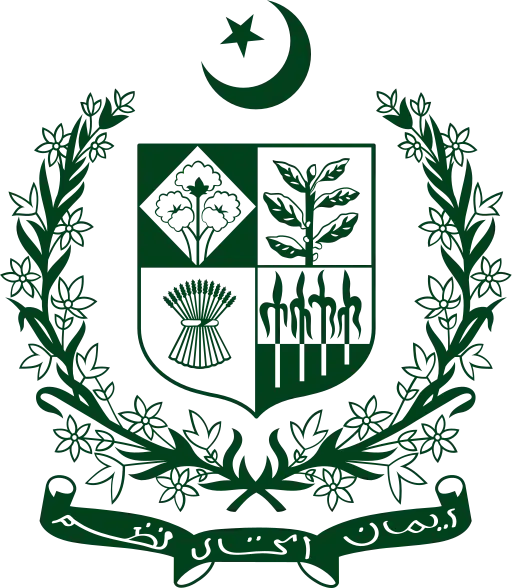Faith, Unity, Discipline
Faith, Unity, Discipline (Urdu: ایمان، اتحاد، تنظیم, romanized: Īmān, Ittiḥād, tanzeem) is the national motto of Pakistan. It is regarded as the guiding principle of Pakistan's nationhood.[1]
| ||
|---|---|---|
|
Governor-General of Pakistan
Parties Properties Tributes
|
||

Upon the independence of Pakistan, it was introduced and adopted as the national motto by the country's founder Muhammad Ali Jinnah.[2] It is inscribed in Urdu at the base of the state emblem. The emblem itself is an adaptation of four components: wreath, crescent, star and scroll, with all components in the shield bounded by the wreath of the jasmine flower, and the crescent and star crest depicted at the top.[3]
Origin
The origin of the motto is derived from the country's founding father Muhammad Ali Jinnah. Jinnah related it to his personal example of life, and instilled a message to the youth of his time, as well as for Pakistan's future generations.[4]
On 28 December 1947, four months after the emergence of Pakistan on the world's map, Jinnah said:
"We are going through fire: the sunshine has yet to come. But I have no doubt that with Unity, Faith and Discipline we will compare with any nation of the world. Are you prepared to undergo the fire? You must make up your minds now. We must sink individualism and petty jealousies and make up our minds to serve the people with honesty and faithfulness. We are passing through a period of fear, danger, and menace. We must have faith, unity and discipline."[5]
Jinnah delivered many addresses describing faith, unity and discipline. On 23 March 1945, he said:
"In Pakistan lies our deliverance, defence and honour…In our solidarity, unity and discipline lie the strength, power and sanction behind us to carry on this fight successfully. No sacrifice should be considered too great. I can assure you that there is nothing greater in this world than your own conscience and, when you appear before God, you can say that you performed your duty with the highest sense of integrity, honesty and with loyalty and faithfulness."[6]
On 11 September 1948, Jinnah gave his last message:
"The foundations of your state have been laid and it is now for you to build and build as quickly and as well as you can. Pakistan is proud of her youth, particularly the students, who are nation builders of tomorrow. They must fully equip themselves by discipline, education, and training for the arduous task lying ahead of them. With faith, discipline, unity and selfless devotion to duty, there is nothing worthwhile that you cannot achieve."[7]
| In Urdu | Roman Urdu transliteration | In English |
|---|---|---|
|
|
|
Popular connotations
Popular connotations also include:[8]
- in English
- Unity, Faith, Discipline
- Unity, Faith and Discipline
- In Urdu Transliteration
- Iman, Ittehad, Nazm
- Iman, Ittehad, Tanzeem
- Iman, Ittehad, Munazam
- Ittehad, Yaqeen, Tanzeem
- Ittehad, Tanzeem, Yaqeen-e-Mohkam[9]
See also
External links
References
- "The State Emblem". Ministry of Information and Broadcasting, Government of Pakistan. Archived from the original on 1 July 2007. Retrieved 18 December 2013.
- "Faith, unity and discipline". The Nation. 25 December 2013. Retrieved 25 November 2014.
- "Unity, Faith and Discipline, the interesting principle of Quaid-e-Azam". Pakistan Today. 29 June 2011. Retrieved 5 November 2014.
- Niazi, Zamir (18 September 2017). "Jinnah and Iqbal in a 'new' light". Dawn. Retrieved 19 September 2017.
- "Slogan of Babab-e-Qaum". Farukh Siddiqui. 5 December 2009. Retrieved 5 November 2014.
- "APPEAL TO ALL PAKISTANIS! - "Unity, Faith, Discipline", Do we follow Quaid's Message?". Hassan.com. 28 December 2011. Retrieved 5 November 2014.
- "Quaid-i-Azam: Unity, Faith, Discipline". Dawn News. 24 December 2011. Retrieved 5 November 2014.
- "Connotations of Quaid's Motto Unity Faith And Discipline". 10 February 2012. Retrieved 5 November 2014.
- Alam, Amra (2020). "Ittehad, Tanzeem, Yaqeen-e-Mohkam". Oxford University Press Pakistan. Retrieved 13 July 2020.
